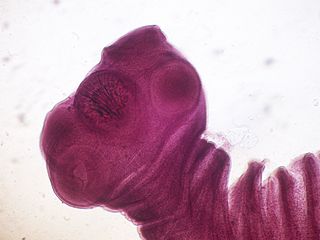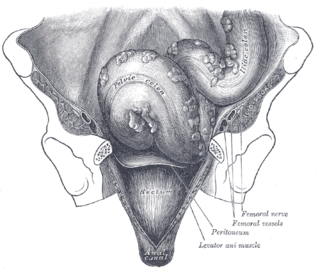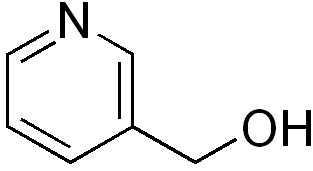Related Research Articles
Medical physics deals with the application of the concepts and methods of physics to the prevention, diagnosis and treatment of human diseases with a specific goal of improving human health and well-being. Since 2008, medical physics has been included as a health profession according to International Standard Classification of Occupation of the International Labour Organization.

Cysticercosis is a tissue infection caused by the young form of the pork tapeworm. People may have few or no symptoms for years. In some cases, particularly in Asia, solid lumps of between one and two centimetres may develop under the skin. After months or years these lumps can become painful and swollen and then resolve. A specific form called neurocysticercosis, which affects the brain, can cause neurological symptoms. In developing countries this is one of the most common causes of seizures.

Praziquantel (PZQ), sold under the brandname Biltricide among others, is a medication used to treat a number of types of parasitic worm infections in mammals, birds, amphibians, reptiles, and fish. In humans specifically, it is used to treat schistosomiasis, clonorchiasis, opisthorchiasis, tapeworm infections, cysticercosis, echinococcosis, paragonimiasis, fasciolopsiasis, and fasciolosis. It should not be used for worm infections of the eye. It is taken by mouth.

Taenia solium, the pork tapeworm, belongs to the cyclophyllid cestode family Taeniidae. It is found throughout the world and is most common in countries where pork is eaten. It is a tapeworm that uses humans as its definitive host and pigs as the intermediate or secondary hosts. It is transmitted to pigs through human feces that contain the parasite eggs and contaminate their fodder. Pigs ingest the eggs, which develop into larvae, then into oncospheres, and ultimately into infective tapeworm cysts, called cysticercus. Humans acquire the cysts through consumption of uncooked or under-cooked pork and the cysts grow into an adult worms in the small intestine.

Taenia saginata, commonly known as the beef tapeworm, is a zoonotic tapeworm belonging to the order Cyclophyllidea and genus Taenia. It is an intestinal parasite in humans causing taeniasis and cysticercosis in cattle. Cattle are the intermediate hosts, where larval development occurs, while humans are definitive hosts harbouring the adult worms. It is found globally and most prevalently where cattle are raised and beef is consumed. It is relatively common in Africa, Europe, Southeast Asia, South Asia, and Latin America. Humans are generally infected as a result of eating raw or undercooked beef which contains the infective larvae, called cysticerci. As hermaphrodites, each body segment called proglottid has complete sets of both male and female reproductive systems. Thus, reproduction is by self-fertilisation. From humans, embryonated eggs, called oncospheres, are released with faeces and are transmitted to cattle through contaminated fodder. Oncospheres develop inside muscle, liver, and lungs of cattle into infective cysticerci.

The Wellcome Library is a free library and Museum based in central London. It was developed from the collection formed by Sir Henry Wellcome (1853–1936), whose personal wealth allowed him to create one of the most ambitious collections of the 20th century. Henry Wellcome's interest was the history of medicine in a broad sense and included subjects such as alchemy or witchcraft, but also anthropology and ethnography. Since Henry Wellcome's death in 1936, the Wellcome Trust has been responsible for maintaining the Library's collection and funding its acquisitions. The library is free and open to the public.

Taenia crassiceps is a tapeworm in the family Taeniidae. It is a parasitic organism whose adult form infects the intestine of carnivores, like canids. It is related to Taenia solium, the pork tapeworm, and to Taenia saginata, the beef tapeworm. It is commonly found in the Northern Hemisphere, especially throughout Canada and the northern United States.

The Taeniidae are a family of tapeworms. It is the largest family representing the order Cyclophyllidea. It includes many species of medical and veterinary importance, as Taenia solium, Taenia saginata, and Echinococcus granulosus. The Taeniidae are parasites of mammals and many are infectious to humans.

Taenia pisiformis, commonly called the rabbit tapeworm, is an endoparasitic tapeworm which causes infection in lagomorphs, rodents, and carnivores. Adult T. pisiformis typically occur within the small intestines of the definitive hosts, the carnivores. Lagomorphs, the intermediate hosts, are infected by fecal contamination of grasses and other food sources by the definitive hosts. The larval stage is often referred to as Cysticercus pisiformis and is found on the livers and peritoneal cavities of the intermediate hosts. T. pisiformis can be found worldwide.

Taeniasis is an infection within the intestines by adult tapeworms belonging to the genus Taenia. There are generally no or only mild symptoms. Symptoms may occasionally include weight loss or abdominal pain. Segments of tapeworm may be seen in the stool. Complications of pork tapeworm may include cysticercosis.

Neurocysticercosis is a specific form of the infectious parasitic disease cysticercosis that is caused by the infection with Taenia solium, a tapeworm found in pigs. Neurocysticercosis occurs when cysts formed by the infection take hold within the brain, causing neurologic syndromes such as epileptic seizures. It is a common cause of seizures worldwide. It has been called a "hidden epidemic" and "arguably the most common parasitic disease of the human nervous system". Common symptoms of neurocysticercosis include seizures, headaches, blindness, meningitis, and dementia.
Professor Marshall Lightowlers began his career in the field of parasitology during a post-doctoral appointment at the Institute of Medical and Veterinary Science in Adelaide where he undertook research on ovine sarcocystosis. In 1981 he began a post-doctoral position at The University of Melbourne, Veterinary Clinical Centre and commenced a research career focusing on the immunology and molecular biology of taeniid cestode parasites. His initial research at the University of Melbourne investigated the immunochemistry of antigens of Taenia taeniaeformis and Echinococcus granulosus. Subsequently he was a member of a team of scientists that developed a vaccine against Taenia ovis infection in sheep, the first recombinant vaccine against a parasitic disease. In 1989 Lightowlers took over leadership of the molecular parasitology research laboratories at the University of Melbourne and began applying the lessons learnt with T. ovis to the development of similar vaccines against infection with the larval stages of other cestode parasites. This led to the development of highly effective, recombinant vaccines against cysticercosis in cattle due to Taenia saginata (TSA9/TSA18) and in pigs due to Taenia solium. In collaboration with Dr David Heath at the Wallaceville Animal Research Centre in New Zealand, he and his colleagues also developed the EG95 recombinant vaccine against cystic echinococcosis.

The taeniae coli are three separate longitudinal ribbons of smooth muscle on the outside of the ascending, transverse, descending and sigmoid colons. They are visible and can be seen just below the serosa or fibrosa. There are three teniae coli: mesocolic, free and omental taeniae coli. The teniae coli contract lengthwise to produce the haustra, the bulges in the colon.

Nicotinyl alcohol (pyridylcarbinol) is a niacin derivative used as a hypolipidemic agent and as a vasodilator. It causes flushing and may decrease blood pressure.
Epoetin beta (INN), sold under the brand name Neorecormon among others, is a synthetic, recombinant form of erythropoietin, a protein that promotes the production of red blood cells. It is an erythropoiesis-stimulating agent (ESA) that is used to treat anemia, commonly associated with chronic kidney failure and cancer chemotherapy.
An anticestodal agent is a drug used in deworming to combat tapeworm infection. It derives its name from Cestoda.
Taenia asiatica, commonly known as Asian taenia or Asian tapeworm, is a parasitic tapeworm of humans and pigs. It is one of the three species of Taenia infecting humans and causes taeniasis. Discovered only in 1980s from Taiwan and other East Asian countries as an unusual species, it is so notoriously similar to Taenia saginata, the beef tapeworm, that it was for a time regarded as a slightly different strain. But anomaly arose as the tapeworm is not of cattle origin, but of pigs. Morphological details also showed significant variations, such as presence of rostellar hooks, shorter body, and fewer body segments. The scientific name designated was then Asian T. saginata. But the taxonomic consensus turns out to be that it is a unique species. It was in 1993 that two Korean parasitologists, Keeseon S. Eom and Han Jong Rim, provided the biological bases for classifying it into a separate species. The use of mitochondrial genome sequence and molecular phylogeny in the late 2000s established the taxonomic status.

Gottlieb Heinrich Friedrich Küchenmeister was a German physician.
Taenia serialis, also known as a Canid tapeworm, is found within canines such as foxes and dogs. Adult T. serialis are parasites of carnivores, particularly dogs, with herbivorous lagomorph mammals such as rabbits and hares, serving as intermediate hosts. In definitive hosts, T. serialis is acquired by eating tissues from a variety of intermediate hosts. Accidental infection of humans though, can occur when eggs are ingested from food or water contaminated with dog feces and the human then becomes the T. serialis intermediate host.

Bunamidine is an anthelmintic drug used in veterinary medicine to treat infections by tapeworm parasites of the genus Taenia; thus it is classified as a taeniacide.
References
- ↑ "taeniacide" at Dorland's Medical Dictionary
- ↑ Hirasaki, Shoji; Murakami, Kazutoshi; Mizushima, Takaaki; Hiramatsu, Kazuhisa; Hanayama, Yoshihisa; Kanamori, Tatsuya; Koide, Norio (2012). "Long-term Taenia saginata Infection Successfully Treated with Meglumine/Diatrizoate Sodium". Internal Medicine. 51 (2): 177–179. doi:10.2169/internalmedicine.51.6499. PMID 22246486.
- 1 2 3 "CDC - Taeniasis - Resources for Health Professionals". 15 October 2020.
- ↑ "Bunamidine".